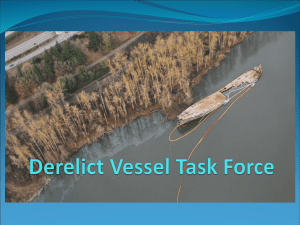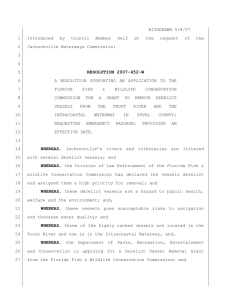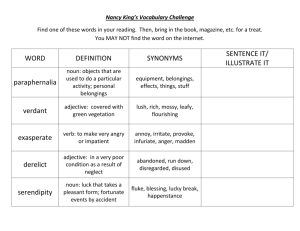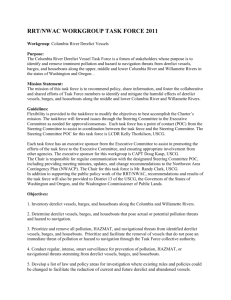14TH INTERNATIONAL CONGRESS OF THE
advertisement
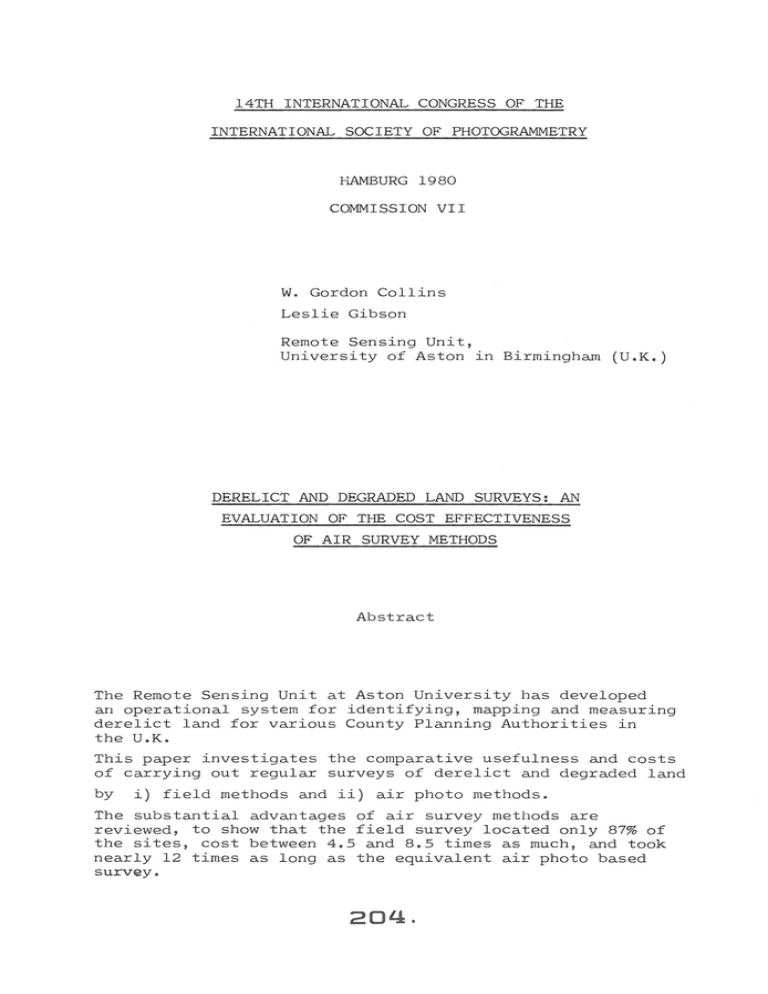
14TH INTERNATIONAL CONGRESS OF THE
INTERNATIONAL SOCIETY OF PHOTOGRAMMETRY
HAMBURG 1980
COMMISSION VII
W. Gordon Collins
Leslie Gibson
Remote Sensing Unit,
University of Aston in Birmingham (U . K . )
DERELICT AND DEGRADED LAND SURVEYS : AN
EVALUATION OF THE COST EFFECTIVENESS
OF AIR SURVEY METHODS
Abstract
The Remote Sensing Unit at Aston University has developed
an operational system for identifying , mapping and measuring
derelict land for various County Planning Authorities in
the U . K .
This paper investigates the comparative usefulness and costs
of carrying out regular surveys of derelict and degraded land
by
i) field methods and ii) air photo methods .
The substantial advantages of air survey methods are
reviewed , to show that the field survey located only 87% of
the sites , cost between 4 . 5 and 8 . 5 times as much , and took
nearly 12 times as long as the equivalent air photo based
survey .
National Surveys of Derelic t Land
Historical development:
Since 1964 a ll local authorities
have been required by national government to submit returns
of the amount, and to some extent the type, of derelict land
found within their administrative are a.
The first survey
was initiated by the Ministry of Housing and Local Government
(M .H.L.G. ) and covered England and Wales, while subsequent
surveys were the concern of the Welsh Office for Wales, and
the M.H.L.G. (Department of the Environmen t after 1971) for
England.
Ot he r, and perhaps more significant changes which have taken
place concern the form of t he survey and the nature of the
information which was recorded.
Until 1 969 in Wal es and
until 1971 in England, the data which were requ ired consisted
of t:1e following:
1.
the amount of derelict land at the end of the survey year
(including those acreages justifying treatment and lands caping) .
2. the amount of derelict land treated during the survey year
(including areas recl aimed or landscaped) .
3. the amount of derelict lan d to be recl ai med in the year
following that of the survey (including areas to be
landscaped).
Each of the above were subdivided into only three ca tegories :
11
spoil heaps 11 , 11 excavations and pi ts 11 and 11 other forms of
dereliction 11 , and all figures were given to the nearest acre.
These 'bas ic category' survey s were based on a definition of
derelict land as being 11 land so damaged by industrial or
other development that it i s incapable of beneficial use
without treatment 11 (M . H .L. G . 1964).
In addition the purpose of the surveys was 11 to ascertain the
amount of such (derelict) land which in the opinion of the
local authorities justified rehabilitation and which was
unlikely to be treated except by the authorities or other
public bodies 12 MHLG ( 1965)
More specifically Oxenham (1 969 ) stated that the aim of the
surveys was to determine the amount of dereliction likely to
rank for gr ant aid, although he conceded that it was essential from a technical standpoint to know the total extent of
dereliction i n order to plan a comprehens ive programme of
reclamation .
Those planning authorities and research workers most concerned with the problems of dereliction, however, whilst agreeing
with the aim of the survey, felt that the government definition was too narrow.
The reasons for this were that under
a list of exclusions to the definition, active areas of
industrial land use were not considered, and certain types of
land use wl1ich to all intent and purpose seemed derelict
(e .g. war-damaged land and War Office areas) were also
excluded.
It was felt that this led to a <,ross underestirna-
205.
tion of the total problem and consequently reduced tlie amount
of available grant.
In a sample area of the West Riding of Yorksi1ire, for
example, it was found t;lat tl1e total area of spoiled land
which should be considered was four times that figure regarded as derelict for: Ministry purposes (Bush and Collins, 1973).
The Nottinghamshire and Derbyshire Sub Regional Study indicated that an area of 2,350 hectares (ha) was a more realistic
estimate than the officially recognised 1,540 ha, while
Monmouthshire thought the area of dereliction should be
almost twice as great as that officially accepted (Notts./
Derby 1969; Welsh Office 1972, respectively).
Even a report
on the reclamation and clearance of derelict land for the
second 11 Countryside in 1970 11 conference, whilst using the
Government definition for ease of data collection, agreed
that the official figures indicated only the 11 hard core 11 of
the dereliction and that the true amount could easily be
twice as much (Study Group 12, 1965).
The significance of this dissatisfaction and the later
increase in greater environmental concern, is that changes
were subsequently made in both the concept of dereliction and
the survey procedure adopted in its survey.
Although the
Welsh Office led the way in 1969 when the original survey
was discontinued, the Department of the Environment (DOE)
followed suit in 1971, with a survey designed to take effect
from lst April, 1974:
the inaugural day of the local government reorganisation!
The new survey still contains room
for improvement, but this will be discussed later in the
context of the West Midlands survey.
The 1974 survey of derelict land in England:
In their
revised and greatly extended survey, the DOE included many
categories of dereliction previously excluded, and also
considered active surface mineral workings and refuse tipping.
More emphasis was given to the existence (or lack) of restoration conditions, and provision was made for explaining
any increases in dereliction from one period to another.
(Previously this latter information might be disguised by
recla1nation figures).
The greater level of detail which was
required is indicated by the fact that active surface mineral
workings are subdivided into mineral classes and not merely
termed 11 excavations and pits 11 as used for derelict workings.
Thus the survey placed the problem of dereliction in its
broader context of mineral planning, waste disposal and
reclamation.
Although the amount and type of data required was more
comprehensive than before, many authorities undoubtedly
carried out their surveys in the manner to which they had
become accustomed, utilizing ground survey methods, relying
on the knowledge of staff and incorporating data held in the
planning office.
Others such as the West Midlands, and
Merseyside Metropolitan County Councils probably realized
that the staffing and financial input into the extended
survey could not be much greater than for the earlier, less
demanding surveys, and that the time spent in collecting the
206.
new data should not unduly interfere with the workings of the
planning departments.
Consequently an efficient and speedy,
but accurate survey method was required.
Past research and experience had shown that the use of aerial
photographs would satisfy these requirements and it was in
this context that U1e Remote Sensing Unit at Aston undertook
to carry out tile first derelict land survey for the West
Midlands County Council using air survey methods.
Aerial Photography and Derelict Land Surveys:
Although aerial
photographs have been used for quantitative surveying for the
production of rnaps and plans (see Belling, 1966, for example),
there is little evidence to show their use in qualitative
survey work.
A survey by Denton (1973) which attempted to
establish the degree to which aerial survey was used by local
planning authorities in Great Britain, showed that 45% of
those authorities which had used aerial photography in the
five years preceding his survey, had done so in relation to
derelict land studies and that this application was eighth
out of a total of nineteen listed.
The relative importance
of photographs for such a use is recorded as being considerably greater in Scotland, but in all cases there 1s no
indication as to the exact nature of the usage.
The West Midlands Derelict Land Survey
Survey classification:
A first step in preparation for the
survey was to decide which classification of derelict land
would be used.
In the light of experience gained by the
Remote Sensing Unit in surveys of this nature and considering
the requirements of the County Council, a suitaole classification was derived after consultation between the Unit and
representatives of the County Planning Department.
The data which were to be collected are as set out 1n Table 1
and relate mainly to site location, its area, the nature of
the dereliction or active working found within the site, the
nature of any vegetation cover and the type of surrounding
land use. Most classes are reasonably self-explanatory but
several require further explanation.
The first four sub-divisions of "Type of dereliction" are
categories which relate specifically to the DOE survey
classification while the remaining sub-divisions are partly
included in the Department's "Ot~1er forms of dereliction".
The notable exception is "Neglected waste land" which is not
included by ti1e DOE, but which is of great significance to
the West Midlands County.
Such land has been described by
Wood (1976) and includes,
(a) areas damaged by development, either past or current
which is subject to planning conditions or other arrangements providing for after treatment (including land
currently being worked for minerals but having inadequate
restoration conditions and accordingly land which is likely to becohle officially derelict at some future time).
(b) land in temporary use ancilliary to current industrial
207.
or other recognised use
(c) land damaged by development and abandoned.
The importance of "l,; eglected waste land" or "waste land" to
which it is subsequently referred, is discussed later.
The "Wet or dry" class of the derelict land classification
refers to standing water present on sites and excludes natural
and man-made drainage channels.
Such "ponded water" may
have resulted from breaching the water table level, particularly in excavations, or by inhibiting the natural flow of water
through the soil (if present) or sub strata. Whether the
site is wet or dry is most significant since it will influence
the use to which a site can be subsequently put, especially
if tipping is being considered.
The "Vegetation type and cover 11 is also significant to the
reclamation and after use of sites, since such data will
suggest;
(a) whether any 11 cosmetic treatment 11 is needed if the site is
not to be assigned a specific use
(b) whether tl1ere is sufficient vegetation to complement any
landscaping work inherent in a development scheme
(c) whether there is sufficient cover to screen any temporary
but environmentally detracting activities such as waste
tipping
(d) the degree of stability of spoil heaps
(e) the nature of any underlying soil i.e. whether the soil
is well established, free from toxic substances, well
drained etc .
The 11 Surrounding land use 11 will have a large influence in
deciding the after use of a derelict site.
F'or example,
developing a site which is in a residential area, for amenity
or community purposes, may well be more desirable than
establishing an industrial estate. Conversely, industrial
re-development in an industrial area may be more appropriate
than building houses.
The areal extent of the site will also
be significant.
The geological sub-divisions (class 12) relate to those listed
by tile DOE for describing the nature of mineral workings.
Sub-divisions which are not shown are not present in the West
Midlands and are, therefore, not included in this particular
classification . This listing could be obviously adapted,
however, for surveys of other counties where other minerals
are significant .
Ti1e final class of 11 Access points 11 is important in considering excavations and pits for tipping purposes .
Other data sources:
Having established the classification of
the data that were to be collected, and obtained the necessary photographic converage of the county, it only remained to
assemble the data sources which would supplement the air photo
208.
interpretation .
These were Ordnance Survey maps of 1 : 10,000
or 1 : 10,560 scale, depending on those areas which had been
mapped at the new metric scale, and the Geological Survey maps
of 1 : 63,360 scale .
Survey method : Using the resources outlined above, the Remote
Sensing Unit survey team interpreted the aerial photographs ,
viewing them stereoscopically using Wild ST4 stereoscopes
fitted with 3x and 8x binoculars and parallel guidance
mechanisms . The data were originally recorded on acetate
overlays placed over alternate aerial photographs and then
transferred using a Bausch and Lomb Zoom Transferscope, to
a transparent base map which overlay a 1 : 10 , 000 scale 0/S
National Grid map .
Survey Results :
In the case of the county being considered,
the total extent of the air photo based survey was 902 km2,
and extended across all or part of 52 0/S maps at a scale of
1 : 10 , 000 , each map covering Skm x Skm .
A total of 2404 derelict and degraded land sites were identified , and the details of every site were recorded (Figure 1)
and mapped in black (Figure 2) .
In addition many other sites
were identif i ed and mapped only - initially in blue .
These
sites were smaller than the 0 . 5 ha minimum cell size set for
this survey .
The area of each site was measured and the total area for the
county was 7 , 546 ha of derelict and degraded land .
Analysis :
a) Air Photo based survey and mapping
902 km 2
2404 sites
7546 ha
Area of Survey
Number of sites recorded
Total area of sites recorded
Cost of data extraction , measuring, mapping
and recording
1/ 50 per 1 km 2 (902 km 2 ) = # 45,100
Average costs (excluding flying and photography)
.
2
2 . 7 sites per lkm 2
67 s1tes per 25km
8 . 4 ha per 1 km2
210 ha per 2Skm2
2
(A single 1 : 10 , 000 0/S map covers 25km )
2
per lkm of survey area
per 2 . 7 sites
1/50 per 8 . 4 ha
i so
$so
'$
#
18 . 5 per site
6 . 0 per ha
b) Average cost of flying and photography Jso , ooo
Iss per lkm 2 total air cover
l 21 per site surveyed
J 7 per ha for sites surveyed
The above figures assume that the photograph y is to be used
e x clusively for the derelict and degraded land survey .
In
the case of the West Midlands the photography was also used
for a total survey of Potential Waste Disposal Sites , and for
209.
a wide range of data collection and mapping tasks .
It is estimated that about one fifth of the total cost of the
flying programme should be charged to the derelict land survey .
This will reduce the above figures as follows :2
$Ql per lkm total air cover
,$4 per site
#1 . 5 per ha for sites surveyed
c) Field Survey Costs : A total of five 1 : 10,000 0/S maps , each
covering 25km2, (i . e . l25km2 in total) were chosen as a sample,
and one fifth of each map i . e . 5km2 was taken to determine the
cost of carrying out a similar survey . This gave a total
sample area of 25km2 . The ojs maps were used as base maps
upon which to outline the location and extent of each site .
Identical information was recorded to that of the air photo
based survey .
2
The total cost for the 25km sample survey included wages,
travel , and subsistence allowance appropriate to the work.
A total of 73 sites were located which extended over an area
of 224ha costing $12,950 .
The sample area of 25km 2 contained 73 sites which together
totalled an area of 224ha which had to be field surveyed .
Comparison of costs :
Table 2a details the comparative costs
of carrying out the surveys .
The costs of the field survey
are compared with two different costings of the air photo
oased survey :
one in which the entire cost of the flying is
i n cluded, the other ln which o n e fifth of the flying costs
are included .
The results of this comparison clearly indicate the economic
advantages of the air photo based systen1 for mapping derelict
and degraded land .
It shows that field survey methods are
between 4 . 5 times and 8 . 5 times more expensive than air photo
based methods .
The precise value of this cost relationship depends on the
unit being considered i . e . the total area of the County being
flown and surveyed, or the cost per site identified, or the
cost per hectare of the sites identified , measured and mapped .
There will also be variations in the contract price of the
flying and the relative cost effectiveness of the field survey
team .
However, the results of this study provide a real live
case, and broadly demonstrate · the relative financial advant ages of using aerial survey methods for identifying, mapping
and measuring derelict and degraded land .
There are other additional advantages , including accuracy
and speed . The air photo view is total and virtually
unimpeded ; very few sites of any significance are hidden
from view .
This contrasts sharply with a field survey where
a restricted viewpoint and constraints of physical access do
not permit a ' total ' survey to be carried out .
These problems are evident when comparing the results of the
field and air photo surveys of the 25km2 sample area . The
results (Table 2~)show that the field survey failed to locate
2:10.
11 sites extending over a total area of 27ha .
The field
survey located only 87% of the sites identified from the
aerial photography .
In terms of speed , the time taken to field survey the 25km 2
was 2 , 237 man hours .
The time taken, by air photo interpretation, to extract and map the same area (but including the
11 extra sites) was 193 man hours .
This showed that the air photo survey was 11 . 6 times faster
than the field survey, with the proviso that the time and
delays of obtaining the aerial photography did not enter into
the considerations as the County Authority supplied all the
material when it became available .
Another major advantage in air photo based survey is that it
provides a permanent , ' true ', record of the field situation :
a unique land/environment data bank, fixed in time and space .
By carrying out aerial photography on a regular basis, it is
possible to monitor more accurately the various changes which
occur . Land use is dynamic, and for effective planning it is
necessary to know not only what it is, where it is , and how
much of it there is, but also its rate and direction of change .
Much of the work undertaken by the Remote Sensing Unit at the
University of Aston has involved monitoring change .
By the
use of aerial photographs as a data source it is possible to
compile a classification of a particular aspect of land use .
This can then be applied to photography taken many years
previously .
This facility for carrying out surveys 'in
retrospectY is rarely available in field surveys, where the
original objectives , definitions and classifications of the
units being surveyed are fixed , selective, and cannot be
altered to supply the data needs of a current survey .
Although this paper deals with the surveying and mapping of
dere lict and degraded land, and clearly demonstrates the
relative advantages of aerial survey methods, much of what has
been written applies equally wel l to many other aspects of
land use surveying and mapping .
Indeed the authors conclude with the comment that the most
cost- effective method of acquiring a wide range of land use/
landscape/environmental data is by having aerial photography
taken at regular intervals to provide a massive land/environment data bank .
References
BEL.Lt=-:G, ..:i.E., 1966 , "Phot:ogrammetry 3.5 an aid tu mine survP.ying", Journ, Inst. :-fine Sarveyors oi Sou"th Af•i ca , 14, p.l48-l 50.
BUSH, P.W., a."ld CCLLI~S, :.~.c., 1973, "'!he aoolicat.1.on o f aeriaL
photogra.~ t:.y : o surveyo rs of DerelJ.. ct: La.na in.' the ;,: ni ted King don", .:..n Env.1.ronmenta..l Remote Sens.:..:".g: Aoolica.tions and Ac:h.l.eve:!lem:s , ed. by E.C . ~ar=ett a.nd L.F' . CurtiS.
Edwo..rd ..u"nol d,
? · 169 - 181.
'1.1--!.L. G.
t
~f i ni s try
St'B-REG!ONAL P".L.-ANNING
S~udy,
Sub-reg~ona.l.
t~:::'I',
1969, :-iot:t: 5 / 0arby
Planm.ng Cnit ,
Der~yshire .
CXE::>.1iA."!., J.R ., :-;.69, Derelict Land C!a.ss i iic a.t:!.on,
:o Jou.--r.. . 'I'ov.TI Plar.nJ.nQ Ins't . 55(3), p.=:Z!.
a. le'tt:e::'
S~Y GRC!..'"P 12 , !.9o55, <;:ec.!.axta:tl.On a..nd C!.ea.ra.nc e of Oe:elict;
"-and, =e?ort -::o 1:!1e second Cownry side in .:..;~-o conference,
Ro· 3.1 Soc:.~'::,: of :l.X"':t and :-o'a.t.ue Conservancy.
D•Jcumen't a:1titled, da.t:ed 13.7.72 . , Welsh
Vf! !. ce, C.l.rdiff.
·,:;:.oo. A.A . , 19 76, Regio r.al Derelic~ Land u.d i.t:s Reclamation ,
renort: '='? '! echnl.ca.l Officers Panel, '.oie ;;;: '1iG.lands ?lar.n:.ng
.l.u':r"'ln.t :. es ~ni<!rence, i). 4 . 76 , 12pp.
oi 1-:ou s i:-.g 3.nd
G.;~vernment:,
~l . H . L.~ ••
Local
1?64. Circular ~a. 55/64,
London =.~P•
Su.b-i<:egiona.J.
'Afl=
_ LS:t CFF"tCE 1972 ,
DEI'l'TON, ;.P . '/1. , 1973, Air Su::vey and Envl.!:cn:nen'ta.l ?1dllninQ.
'-' npu b1.:.sn~d Disserta::ion for Cradca.t:e Cour3 e i:J. Tc""n P!a.::nl.nQ,
Oxford ?olyt:echnic, ~lay .:.973.
Local
~O'ITS / DERBY
19 65, Circul a..:: No . 68/.S5, Hini:5't r :t of Housu:g and
London 3pp.
~verr.rnent,
21:1.
Tal>]<~
Table 2a
l
COST CCJ!'.1PAR ISON
West Midlands Derelict Land Clrtssification
1. Site number
sites numbP.rPd consecutively per
map
2. Geu-code
8 figure ~rid rcfercr1ce;
road narne or local feature
a) API only
acres
u)
3.
Ar~a
4. Type of dereliction
N
1-l
N
Air Photo Survey and Field Survey (Prices in iu.s.)
2
Per km
Per site
Per ha of
site
e!.lld
hecti\res
a Spoil heaps
b Excavations 2nd pits
c Military and other service
dereliction
d Disused rail land
e Disused sewage works a11d
installations
f Disused waterways land
g Neglected waste land
h Other
Total flying
(a + b) Total
d) Field Survey
k) Cost of Field
Survey in relation
to Air Photo Survey
Y - yes; N - No
6. Area of demolition
Y - yes; N - No
7. Used or disused
U -
8. Wet or dry
(excluding stream, drain,
river or canal)
W - Wctter present on site
D - water not present on site
9. Buildings on si.te
Y - yes; N - No
10. Vegetation type and cover
Extent of cover
a - 0-10%; u - 10%-.50%;
c - 50%-100%
Dominant vegetation type
t - trees; s - shrubs; g -grass
I
6.0
55.0
21.0
7.0
105.0
39.5
13.0
.518.0
] 77.0
58.0
4.93x
4.48x
4.46x
a) API only
50.0
18.5
11.0
4.0
1.5
61.0
22.5
7.S
518.0
177.0
SA.O
d) Field Survey
site in use; D - si.te in
disuse
11
18.5
c) one fifth of flying
(a + c) Total
5. Tipping
11. Surrounding land use
I
.50.0
e) Cost of Field
Survey in relation
to Air Photo Survey
8.4'lx
6.0
7~G7x
7.7x
Table 2b
ACCURACY COMPARISON
I
-
Jndu ~~trii\1;
Air Photo Interpretation and Field Survey
R -
0 - other
Mul tiplP usc given
Method
nec-
essary
12. Geology
3
4
6
8
9
clay, shale and marl
coal
igneous rocl<
limestone
sand and gravel
13. Access points
Number of access points over 4m
in width {lloles only). Complete
access referred to as rxo
10 SCltidstone
Extent of sites
{hectares)
API
8-1
251 ha
Field Survey
73
224 ha
resiU.enti?.l;
wh~1. e
Number of sites
identified
% Accuracy of
F'ield Survey
87%
89%
,--~--
?•
1.
r.eo .
Site
an:l.
Nurri:Jer
road
~-
).
).
Area
1)'P"
of
'l'iptJing
4-9
1'!1'~5
p..r,..,l,...,.\.
R.c..c>A
O'liD
l"&CC
::;,t>b~~·......~
"'"""'
0<1S'O -7bSO
so
D<mJlit
ere lie-
ion
ticn
415
"
"·
10.
'1.
<t~~J..hl~
._,._,..,_
Figure 1 .
3
dry
]:)
])
'y.j
N
:D
N
'6 · '57
, '1-1
b
h)
N
.J::>
6
tJ
tJ
u
::l." 95"
8 4
s
Wet:/
-- -----
(,-0~
2·'1-b
Usc<l/
tisused
-----
11.
1?.
1).
Veget;'\tlon
Cede
n.c~re
o'\,S
(.
(,.
----~---
Buildings
surr-
r-.~_~lcgy
/trc•-,Gr1
r
CUTKling
11 r, t.:;
ptent
1l'P"
b
.s
;>..
N
b
s
0
3
I
y
b
s
0
9
3
on
site
y
~L- --
__ I
DERELICT LAND RECORD FORM
--<)1l!i
C\r
df/7
~
,,.
eo(]3CB
045"1
4UO\J:Ib
D181
1'1455
450 0454
131<§{5
t;J
fA, l02
\720<
"'11ll
"134
477
\S2.16
~~404
~229
~>..,_
403
DERELICT
LAND 1977
1 km
Figure 2 .
2:13.
4S90
--

